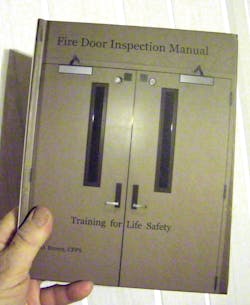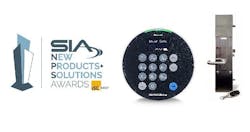The inspection of fire doors is currently a hot topic around the fire hydrant these days, with the expectation that municipalities will recognize the benefits of scheduled fire door inspections and adapt the NFPA 80 and other codes which specify annual or performance-based fire door inspections “be performed by individuals with knowledge and understanding of the operating components of the type of door being subject to testing.”
Since much locksmithing involves working on swinging doors in buildings, and in commercial buildings the majority of the doors are labeled, locksmiths are well positioned to offer inspection and repair services.
Although the primary objects of your affection in a facility are those openings you have equipped with access control and locking devices; remember that there are lots of doors in a facility which may not be access controlled or means of egress but are labeled and therefore must also conform to the code and be inspected.
From the feedback we receive from Locksmith Ledger readers we understand that locksmithing is under siege. Home improvement retailers are undercutting our hardware pricing; electricians and telecom contractors are eying our specialties; cabbies and tow truck operators are grabbing the lockouts and other trades are diversifying.
Locksmiths are looking to broaden their activities in order to keep their shops open. So is suggesting that inspecting doors such a quantum leap?
Who Will Inspect?
Large facilities must try to determine if it is in their best interests to delegate an employee and get that person trained to do inspections, hire an outside firm to do the inspections, or let an existing vendor such as their locksmith or door and hardware provider provide the service.
Although annual inspections sound reasonable, in high traffic facilities, high risk facilities such as nursing homes or older structures with older doors and hardware, facilities managers need to be constantly aware of the condition of the doors, and be able to quickly assess issues and be prepared to “resolve deficiencies without delay.”
For example, a nursing home client has established a routine of testing the doors, keypads, delayed egress and door alarms (to let nurses know a patient is wandering), and will occasionally find a door that suddenly is not operating properly.
Different clients will have different policies regarding the proper operation of their doors. Maybe they are highly conscientious about ensuring the building occupants are safe. Maybe they aren’t able to spot problems themselves. Maybe the building is old and things simply wear out. Maybe they don’t care, and would rather wait to be forced to make repairs.
That is why codes are so important. We know there is a law that says every door must be inspected at least once a year, and if a deficiency is found, it be repaired. Management operates more efficiently when the there is a schedule to follow and the potential of a fine or worse if the rules are not obeyed.
Being able to repair locks and doors is a honorable profession, and being able to properly inspect doors, identify problems, and also be able to remedy the deficits is a valuable service to render to your clients.
Most of us accept the fact that one person cannot know everything and that we’re only human and we may make mistakes. These rules apply to Local Authorities Having Jurisdiction (LAHJs) too, although it is not a good idea to tell them they don’t know it all, and point out to him that the last time he walked through he overlooked a bunch of violations.
Locksmiths and security professionals act as auxiliary LAHJs, the civilian branch that helps the LAHJs cover all the bases. In many situations we understand the operation of the equipment better than the LAHJ. So when you are inspecting doors or surveying premises, you are doing the best you can, and you are not too proud to reach out for help on tough situations.
If you do not have a desire to become an inspector, you can still check out doors on your customers’ premises and alert them to deficiencies in the interests of life safety and then quote them the required repairs in the interests of meeting payroll.
For locksmiths providing access control, knowing what the code requires of a labeled fire door will ensure you are not creating a violation which will endanger occupants or get flagged later by an LAHJ or Fire Door Assembly Inspector (FDAI).
Fire Doors are governed by the building code and NFPA throughout design, specification, installation and occupancy permitting of a building. Once a Certificate of Occupancy has been issued, the building code is closed. The Fire Code or Life Safety Code is now in effect for the operation and maintenance of the facility.
But often a building will undergo renovations and changes in its tenancy. Also Codes are upgraded. So there you may encounter doors which fall into various points in the spectrum -- those doors in older buildings which time has seemingly forgotten and newer undocumented doors which may have been deployed but fell under the radar. You cannot assume that the door has been already inspected and you can grandfather it through.
I’ve seen Fire Marshals do this, where they know someone in their agency has previously inspected and passed on a premises and door, and they do not want to contradict another official’s judgment. Grandfathering is within the domain of the LAHJ, not the FDAI.
Sometimes different LAHJs inspecting the same condition will arrive at different conclusions. If you have relevant information which might help them reach a resolution, tactfully make them aware of it; for example if a locking device is the issue and you can clarify its approvals and exact sequence of operation, speak up.
In general, you cannot win an argument with your spouse, your boss or the LAHJ.
Thoroughly inspect all the fire doors and report deficiencies to the owner/occupant (and document the deficiencies), Get authorization to make the necessary repairs if the owner/occupant so desires, then bill them for the services rendered. If you encounter an issue during the process and are unsure how to proceed, get help from the AHJ, the building department, or another reliable resource.
It seems perfectly reasonable that if you are asked to repair a lock or other hardware on a door, that you perform an inspection on it and provide it to the customer as part of the service.
Door Inspection Checklist
Swinging Doors with Builders Hardware will be inspected to verify the following:
1. No open holes or breaks exist in surfaces of either the door or frame.
Holes may be caused by any number of reasons, including removal of old hardware. If the door was attacked and it is warped, creased, or has gashes, it probably will not pass.
Body filler is not a code compliant repair material. Steel fasteners or plates welded over the holes, or filling the holes with the same material as the door, is acceptable.
2. Glazing, vision light frames, and glazing beads are intact and securely fastened in place, if so equipped.
Glazing must be a labeled glass light kit and be properly installed as per manufacturer’s instructions. Like fire door labels, each glazing kit will have a label indicating its intended use and ratings.
3. The door, frame, hinges, hardware and non-combustible threshold are secured, aligned, and in working order with no visible signs of damage.
Assembly components must be securely fastened, operational, and the door must swing freely. Most components of a fire door assembly are required to be listed or labeled.
The label itself may be made of metal, paper, or plastics, or may be stamped or diecast into the item. Unless you are able to read the label, you cannot determine the expected performance level and requirements of the assembly. If labels are missing or illegible, the LAHJ may have to be consulted.
Hinges must be ball bearing type or may employ other antifriction bearing surfaces in accordance with ANSI/BHMA A156.1 – Standard for Butts and Hinges but do not require individual labels.
4. No parts are missing or broken.
Improperly repaired fire doors were probably the driver for ramping up NFPA 80 enforcement. It is critical that correctly rated hardware is used for repair of fire door assemblies. NFPA 80 states the repair of any deficiencies must be completed “without delay.”
5. Door clearances at the door edge to the frame, on the pull side of the door, do not exceed clearances listed in 4.8.4 and 6.3.1.
The maximum clearance between the bottom of a fire door and the top of the finished floor or threshold is 3/4″.
Clearances at the perimeter and between the meeting stiles of pairs are measured on the pull side face of the door. Wood doors: must not exceed 1/8″. Hollow metal doors must be between 1/16″ and 3/16″.
6. Self-closing doors shall swing easily and freely and shall be equipped with a closing device to cause the door to close and latch each time it is opened. (NFPA80-2010 6.1.4.2.1)
Spring hinges are also permitted but the test is performed with the door open 30 degrees (NFPA80-2010 A6.4.1.4)
In NFPA 80, door operation is divided into 3 categories:
1) Self-Closing Doors – Normally closed door which opens then closes and relatches each time it is used.
2) Automatic-Closing Doors – Fire Doors which are held open with labeled fail-safe hold-open devices which release upon alarm and allow the door to close.
3) Power-Operated Fire Doors – Fire Doors equipped with automatic operators. Must be installed so that power to the automatic operator is cut when the fire alarm is actuated allowing the door to close and latch.
Fire doors are not required to meet the opening force requirements set forth byADA.
7. If a coordinator is installed, the inactive leaf closes before the active leaf.
The function of a coordinator is to ensure that the leaves of a pair close in the proper sequence.
8. Latching hardware operates and secures the door when the door is in the closed position.
9. Auxiliary hardware items, which interfere or prohibit operation, are not installed on the door and frame.
Common “Auxiliary items” include door stops, and chains.
10. No field modifications to the door assembly have been performed that void the label.
Locking devices may be fire rated, but it does not mean that they may be retrofitted on a fire-rated door and preserve the door’s fire rating. Retrofits and alterations to fire doors and frames are limited by NFPA 80
If an electric strike required cutting into the face of the frame in order to install it, it has probably breached this requirement, and the LAHJ may be consulted. The strike manufacturer can provide further support in this regard. Use this knowledge when you are specifying your own installations.
11. Gasketing and edge seals, where required, are inspected to verify their presence and integrity.
LAHJs may not have the necessary knowledge – or, more importantly, the time – to perform these inspections. They have their hands full inspecting all of the other building systems and components.
This is why the revision to NFPA 80 in 2007 is significant, as it enables building owners and others to supplement the inspection process to help assure that fire doors are kept in proper working order.
While NFPA 80 does not designate a specific group or groups to perform these inspections, the Foundation for Life Safety and Security along with the Door and Hardware Institute have developed an online course which enables individual to obtain FDAI (Fire Door Assembly Inspector) training and certification.
In some cases the LAHJ may agree to what is referred to as a Performance Based Option for Fire Door Inspection. Check out ANNEX J of NFPA-80 5-2.2.
Self Fire Door Inspection
Steven Brown’s company, Self Fire Door Inspection, has a web site and publishes a manual designed to provide building owners and other interested individuals with a reference to enable them to perform fire door inspections. It is an informative publication loaded with information and insights. Following are Locksmith Ledger’s questions and Brown’s answers.
Can someone make money doing fire door inspections?
It has been reported that inspectors are charging $15 to $25 per door for inspections. While the first annual inspection will take a little longer to set up the paper work, the inspector will have to determine what clients are willing to pay.
How long does it take to inspect a door and frame assembly?
If no issues are found, approximately 10 minutes depending on the competence of the inspector.
What if the inspector is not sure if a door meets certification or has an issue?
The manual provides sources for assistance. We suggest two ways to get assistance for free.
Can you provide some information about your background in the door/ door hardware industry?
Credentials: NFPA, Certified Fire Protection Specialist (CFPS) - Twenty plus years in the fire door industry, including the following skills: patented fire and sound doors, Fire door and fire door component development, testing (fire and sound doors), door inspection service center for manufacturers with field issues, a working relationship with almost all wood fire door manufacturers in the US and Canada, steel door temperature rise with one of the largest steel door manufacturers, inventor of a radiation door that does not contain lead, patented sound transmission class (STC) door rated at 48 in fixed testing. To my knowledge, this is the highest rated sound wood flush door on the market that does not contain lead.
Traveled internationally to promote U.S. fire door constructions in Great Britain, Europe and the Middle East.
I have worked with certified testing agencies; Underwriters Laboratories, Warnock Hersey, Exnova, Chiltern, International Fire Consultants. Experienced with ISO 9000, Internationally CE Mark and Q-Mark certifications. National and International Sales. I was also manager for two of the four major firerated component manufacturers in the United States and Canada.
How can our readers contact you to order a book, or get further information?
Readers can contact us through our web site, www.selffdi.com. If they have questions, they can use the “contact us” application.
What motivated you to write this book?
This training manual was developed for three reasons:
1) Life safety
2) Protect property and
3) The opportunity to get as many fire doors inspected in this country as quickly as possible.
The manual was originally designed for maintenance personnel to inspect their own properties. We have found many related fields such as fire extinguisher inspectors, fire alarm inspection, and door or hardware sales groups. Anyone with some knowledge of doors or hardware has an advantage from the start. We feel we could give this manual to high school students and they would be competent to perform these inspections.
What portion of the inspection is the most complicated?
Identifying which doors need to be inspected. If door labels have been removed from the door it can make identifying difficult. Typically many labels have been painted over. My advice is if the door is in a location that has a potential for fire or exit from the building it should be inspected.
How does a mechanic become qualified to perform field work on a UL Listed Fire Door Assembly?
The standard for qualification to inspect fire doors, as specified by NFPA, is the inspector having knowledge of what they are inspecting. Our training manual provides that knowledge and more. They still have to read the material and follow the steps for the inspection.
We have tried to make this process easy by supplying a laminated inspection sheet to carry while inspecting. We have also suggested tools that might be carried during the inspection for minor repairs.
You say that a door can be held in the full open position then released to test it for proper closing/latching. What about doing this test from a 30 degree open position? I cannot cite the source, but that was a criteria for another test I had read about.
I am not sure of your reference to closing from a 30 degree angle. All doors should be tested from full open to ensure they will close completely. An added carpet can hold a door from closing. What you asking is more likely to be measuring the closing time for a door. The information can be found in chapter five, under testing.
Opening and closing force does not appear to be measurable parameter for this inspection. Does this create a conflict with ADA?
You will also find information regarding ADA requirements.
Perfect Raceway
The Perfect Raceway Program is the first Certified Personnel Program ever designed that allows for technicians to field modify fire listed doors, while still maintaining the door listing status.
Complete information about this program may be obtained at: http://www.perfectraceway.com/ or www.whmark.com/raceway.
Fire Door Solutions
Fire Door Solutions was created to assist commercial facilities management departments with the ever changing codes and requirements for fire rated doors. Most facilities management departments are currently maxed out on their responsibilities and manpower.
Fire Door Solutions was formed to help solve issues that every commercial facility encounters and are committed to developing and identifying products and services which make the NFPA 80 code compliance a less challenging tasks for commercial facilities.
Products include:
NFPA 80 Fire Door Inspection Packet
eFireTrack – Fire Door Inspection Software
Services include:
Annual Fire Door Inspections,
Fire Door Code Compliance Training/Education,
Completing and Performing Statement of Conditions and Fire Damper Inspections
For more information, visit www.firedoorsolutions.com
Recommended Resources
NFPA 80 2010
SDI 111-09 STANDARD STEEL DOORS & FRAMES (www.steeldoor.org)
SDI 118-05 BASIC FIRE DOOR REQUIREMENTS
Tim O'Leary
Tim O'Leary is a security consultant, trainer and technician who has also been writing articles on all areas of locksmithing & physical security for many years.






